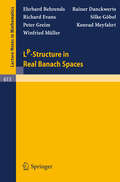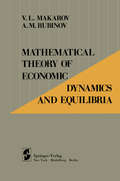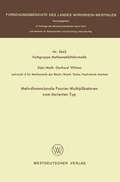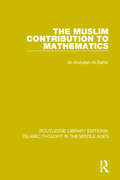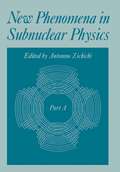- Table View
- List View
Littlewood-Paley and Multiplier Theory (Ergebnisse der Mathematik und ihrer Grenzgebiete. 2. Folge #90)
by R. E. Edwards G. I. GaudryThis book is intended to be a detailed and carefully written account of various versions of the Littlewood-Paley theorem and of some of its applications, together with indications of its general significance in Fourier multiplier theory. We have striven to make the presentation self-contained and unified, and adapted primarily for use by graduate students and established mathematicians who wish to begin studies in these areas: it is certainly not intended for experts in the subject. It has been our experience, and the experience of many of our students and colleagues, that this is an area poorly served by existing books. Their accounts of the subject tend to be either ill-suited to the needs of a beginner, or fragmentary, or, in one or two instances, obscure. We hope that our book will go some way towards filling this gap in the literature. Our presentation of the Littlewood-Paley theorem proceeds along two main lines, the first relating to singular integrals on locally com pact groups, and the second to martingales. Both classical and modern versions of the theorem are dealt with, appropriate to the classical n groups IRn, ?L , Tn and to certain classes of disconnected groups. It is for the disconnected groups of Chapters 4 and 5 that we give two separate accounts of the Littlewood-Paley theorem: the first Fourier analytic, and the second probabilistic.
LP-Structure in Real Banach Spaces (Lecture Notes in Mathematics #613)
by E. Behrends R. Danckwerts S. Evans S. Göbel P. Greim K. Meyfahrt W. MüllerMarches Aleatoires sur les Groupes de Lie (Lecture Notes in Mathematics #624)
by Yves Guivarc'h Michael Keane Bernard RoynetteMathematical Aspects of Finite Element Methods: Proceedings of the Conference Held in Rome, December 10 - 12, 1975 (Lecture Notes in Mathematics #606)
by I. Galligani E. MagenesMathematical Demography: Selected Papers (Biomathematics #6)
by D. Smith Nathan KeyfitzThis volume is an effort to bring together important contributions to the mathe matical development of demography and to suggest briefly their historical context. We have tried to find who first thought of the several concepts and devices commonly used by demographers, what sort of problem he was facing to which the device or concept seemed the solution, and how his invention developed subsequently in the hands of others. Historically, the book starts with a Roman table of life expectancies from the third century a. d. about which we know little, and with John Graunt's explora tions in an area that was still popularly suspect when he wrote in 1662. These are followed by the astronomer Halley, who looked into the field long enough to invent the life table and to notice that Their Majesties would take a sizeable loss on the annuity scheme they had just launched; and by Euler, who was first to devise the formulas of stable population theory and to apply them to filling gaps in data To these we add the handful of further contributions in the 19th century and many pieces from the explosion of contributions that began in this century with Lotka. We doubt that we have managed to trace everything back to its ultimate beginning, and suspect that our nominees in some cases have been anticipated by predecessors who will be turned up by other students.
Mathematical Models in Biological Discovery (Lecture Notes in Biomathematics #13)
by D. L. Solomon C. F. WalterWhen I was asked to help organize an American Association for the Advancement of Science symposium about how mathematical models have con tributed to biology, I agreed immediately. The subject is of immense importance and wide-spread interest. However, too often it is discussed in biologically sterile environments by "mutual admiration society" groups of "theoreticians", many of whom have never seen, and most of whom have never done, an original scientific experiment with the biolog ical materials they attempt to describe in abstract (and often prejudiced) terms. The opportunity to address the topic during an annual meeting of the AAAS was irresistable. In order to try to maintain the integrity ;,f the original intent of the symposium, it was entitled, "Contributions of Mathematical Models to Biological Discovery". This symposium was organized by Daniel Solomon and myself, held during the 141st annual meeting of the AAAS in New York during January, 1975, sponsored by sections G and N (Biological and Medical Sciences) of the AAAS and the North American Regions of the Biometric Society, and supported by grant BMS 75-0280) from the National Science Foundation. What follows in this volume are papers by nine of the participants who not only felt that they had something to say in a symposium entitled, "Contributions of Mathematical Models to Biological Discovery", but who falso were willing to record their ideas in more detail here.
Mathematical Theory of Economic Dynamics and Equilibria
by V.L. Makarov A.M. RubinovThis book is devoted to the mathematical analysis of models of economic dynamics and equilibria. These models form an important part of mathemati cal economics. Models of economic dynamics describe the motion of an economy through time. The basic concept in the study of these models is that of a trajectory, i.e., a sequence of elements of the phase space that describe admissible (possible) development of the economy. From all trajectories, we select those that are" desirable," i.e., optimal in terms of a certain criterion. The apparatus of point-set maps is the appropriate tool for the analysis of these models. The topological aspects of these maps (particularly, the Kakutani fixed-point theorem) are used to study equilibrium models as well as n-person games. To study dynamic models we use a special class of maps which, in this book, are called superlinear maps. The theory of superlinear point-set maps is, obviously, of interest in its own right. This theory is described in the first chapter. Chapters 2-4 are devoted to models of economic dynamics and present a detailed study of the properties of optimal trajectories. These properties are described in terms of theorems on characteristics (on the existence of dual prices) and turnpike theorems (theorems on asymptotic trajectories). In Chapter 5, we state and study a model of economic equilibrium. The basic idea is to establish a theorem about the existence of an equilibrium state for the Arrow-Debreu model and a certain generalization of it.
Mathematics and the Life Sciences: Selected Lectures, Canadian Mathematical Congress, August 1975 (Lecture Notes in Biomathematics #18)
by D. E. MatthewsFor two weeks in August, 1975 more than 140 mathematicians and other scientists gathered at the Universite de Sherbrooke. The occasion was the 15th Biennial Seminar of the Canadian Mathematical Congress, entitled Mathematics and the Life Sciences. Participants in this inter disciplinary gathering included researchers and graduate students in mathematics, seven different areas of biological science, physics, chemistry and medical science. Geographically, those present came from the United States and the United Kingdom as well as from academic departments and government agencies scattered across Canada. In choosing this particular interdisciplinary topic the programme committee had two chief objectives. These were to promote Canadian research in mathematical problems of the life sciences, and to encourage co-operation and exchanges between mathematical scientists" biologists and medical re searchers. To accomplish these objective the committee assembled a stim ulating programme of lectures and talks. Six principal lecturers each delivered a series of five one-hour lectures in which various aspects of the interaction between mathematics and the life sciences were considered. In addition researchers working in the areas of health, population biology, physiology and development biology and disease processes were invited to give more than 25 hours of complementary talks.
Mathematik mit Kalkülen und Maschinen (Logik und Grundlagen der Mathematik)
by Elmar Cohors-FresenborgMathematische Logik mit Informatik-Anwendungen (Heidelberger Taschenbücher #187)
by E. Bergmann H. NollMathematische und naturwissenschaftliche Tafeln: Mit vierstelligen Logarithmen
by Friedrich Kemnitz Rainer EngelhardMeasure and Integral: An Introduction to Real Analysis (Chapman And Hall/crc Pure And Applied Mathematics Ser.)
by Richard WheedenThis volume develops the classical theory of the Lebesgue integral and some of its applications. The integral is initially presented in the context of n-dimensional Euclidean space, following a thorough study of the concepts of outer measure and measure. A more general treatment of the integral, based on an axiomatic approach, is later given.<B
Mehrdimensionale Fourier Multiplikatoren vom iterierten Typ (Forschungsberichte des Landes Nordrhein-Westfalen #2645)
by Gerhard WilmesModular Functions of One Variable V: Proceedings International Conference, University of Bonn, Sonderforschungsbereich Theoretische Mathematik, July 2-14, 1976 (Lecture Notes in Mathematics #601)
by J. P. Serre D. B. ZagierModular Functions of One Variable VI: Proceedings International Conference, University of Bonn, Sonderforschungsbereich Theoretische Mathematik, July 2-14, 1976 (Lecture Notes in Mathematics #627)
by J. P. Serre D. B. ZagierModuli Theory and Classification Theory of Algebraic Varieties (Lecture Notes in Mathematics #620)
by H. PoppThe Muslim Contribution to Mathematics
by Ali Abdullah Al-Daffa'This book, first published in 1977, discusses the Muslim contribution to mathematics during the golden age of Muslim learning from the seventh to the thirteenth century. It was during this period that Muslim culture exerted powerful economic, political and religious influence over a large part of the civilised world. The work of the Muslim scholars was by no means limited to religion, business and government. They researched and extended the theoretical and applied science of the Greeks and Romans of an earlier era in ways that preserved and strengthened man’s knowledge in these important fields. Although the main object of this book is to trace the history of the Muslim contribution to mathematics during the European Dark Ages, some effort is made to explain the progress of mathematical thought and its effects upon present day culture. Certain Muslim mathematicians are mentioned because of the important nature of their ideas in the evolution of mathematical thinking during this earlier era. Muslim mathematicians invented the present arithmetical decimal system and the fundamental operations connected with it – addition, subtraction, multiplication, division, raising to a power, and extracting the square root and the cubic root. They also introduced the ‘zero’ symbol to Western culture which simplified considerably the entire arithmetical system and its fundamental operations; it is no exaggeration if it is said that this specific invention marks the turning point in the development of mathematics into a science.
The Muslim Contribution to Mathematics
by Ali Abdullah Al-Daffa'This book, first published in 1977, discusses the Muslim contribution to mathematics during the golden age of Muslim learning from the seventh to the thirteenth century. It was during this period that Muslim culture exerted powerful economic, political and religious influence over a large part of the civilised world. The work of the Muslim scholars was by no means limited to religion, business and government. They researched and extended the theoretical and applied science of the Greeks and Romans of an earlier era in ways that preserved and strengthened man’s knowledge in these important fields. Although the main object of this book is to trace the history of the Muslim contribution to mathematics during the European Dark Ages, some effort is made to explain the progress of mathematical thought and its effects upon present day culture. Certain Muslim mathematicians are mentioned because of the important nature of their ideas in the evolution of mathematical thinking during this earlier era. Muslim mathematicians invented the present arithmetical decimal system and the fundamental operations connected with it – addition, subtraction, multiplication, division, raising to a power, and extracting the square root and the cubic root. They also introduced the ‘zero’ symbol to Western culture which simplified considerably the entire arithmetical system and its fundamental operations; it is no exaggeration if it is said that this specific invention marks the turning point in the development of mathematics into a science.
Network Models in Population Biology (Biomathematics #7)
by E. R. LewisThis book is an outgrowth of one phase of an upper-division course on quantitative ecology, given each year for the past eight at Berkeley. I am most grateful to the students in that course and to many graduate students in the Berkeley Department of Zoology and Colleges of Engineering and Natural Resources whose spirited discussions inspired much of the book's content. I also am deeply grateful to those faculty colleagues with whom, at one time or another, I have shared courses or seminars in ecology or population biology, D.M. Auslander, L. Demetrius, G. Oster, O.H. Paris, F.A. Pitelka, A.M. Schultz, Y. Takahashi, D.B. Tyler, and P. Vogelhut, all of whom contributed substantially to the development of my thinking in those fields, to my Depart mental colleagues E. Polak and A.J. Thomasian, who guided me into the litera ture on numerical methods and stochastic processes, and to the graduate students who at one time or another have worked with me on population-biology projects, L.M. Brodnax, S-P. Chan, A. Elterman, G.C. Ferrell, D. Green, C. Hayashi, K-L. Lee, W.F. Martin Jr., D. May, J. Stamnes, G.E. Swanson, and I. Weeks, who, together, undoubtedly provided me with the greatest inspiration. I am indebted to the copy-editing and production staff of Springer-Verlag, especially to Ms. M. Muzeniek, for their diligence and skill, and to Mrs. Alice Peters, biomathematics editor, for her patience.
New Phenomena in Subnuclear Physics: Part A (The Subnuclear Series #13)
by Antonino ZichichiIn July 1975 a group of 122 physicists from 68 laboratories of 27 countries met in Erice to attend the 13th Course of the International School of Subnuc1ear Physics. The countries represented at the School were: Australia, Austria, Belgium, Brazil, Canada, Chile, Denmark, France, Germany, Greece, India, Iran, Israel, Italy, Japan, Mexico, The Netherlands, Norway, Poland, Portugal, Spain, Sweden, Switzerland, Turkey, The United Kingdom, The United States of America and Yugoslavia. The School was sponsored by the Italian Ministry of Public Education (MPI), the Italian Ministry of Scientific and Technolog ical Research (MRST) , the North Atlantic Treaty Organization (NATO), the Regional Sicilian Government (ERS) and the Weizmann Institute of Science. The School was one of the most exciting, due to the impressive number of discoveries made not only in the field of the new par ticles by the MIT-BNL (reported by S. C. C. Ting) and by the SLAC SPEAR (reported by M. Breidenbach) Groups, but also in the field of high energy neutrino interactions where Carlo Rubbia observes ~ pairs, together with bumps in the total energy of the hadronic system at Wh~4 GeV and a discontinuity in the at Ev~50 GeV plus a bump at Wmin~4 GeV; all these phenomena being possibly connected. To this remarkable amount of new and exciting results it has to be added the great discovery of DORIS (reported by B. Wiik) on the first example of a new particle Pc: the highlight of the Course.
Non-Commutative Harmonic Analysis: Actes du Colloque d'Analyse Harmonique Non-Commutative, Marseille-Luminy, 5 au Juillet, 1976 (Lecture Notes in Mathematics #587)
by J. Carmona M. VergneNumber Fields (Universitext)
by Daniel A. MarcusRequiring no more than a basic knowledge of abstract algebra, this text presents the mathematics of number fields in a straightforward, pedestrian manner. It therefore avoids local methods and presents proofs in a way that highlights the important parts of the arguments. Readers are assumed to be able to fill in the details, which in many places are left as exercises.
Number Theory Day: Proceedings of the Conference Held at Rockefeller University, New York, 1976 (Lecture Notes in Mathematics #626)
by M. B. NathansonNumerical Methods in Fluid Dynamics (Scientific Computation)
by M. HoltThis monograph is based on a graduate course, Mechanical Engipeering 266, which was developed over a number of years at the University of California-Berkeley. Shorter versions of the course were given at the University of Paris VI in 1969, and at the University of Paris XI in 1972. The course was originally presented as the last of a three quarter sequence on Compressible Flow Theory, with emphasis on the treatment of non-linear problems by numerical techniques. This is reflected in the material of the first half of the book, covering several techniques for handling non-linear wave interaction and other problems in Gas Dynamics. The techniques have their origins in the Method of Characteristics (in both two and three dimensions). Besides reviewing the method itself the more recent techniques derived from it, firstly by Godunov and his group, and secondly by Rusanov and his co-workers, are described. Both these approaches are applicable to steady flows calculated as asymptotic states of unsteady flows and treat elliptic prob lems as limiting forms of unsteady hyperbolic problems. They are there fore applicable to low speed as well a~ to high speed flow problems. The second half of the book covers the treatment of a variety of steady flow problems, including effects of both viscosity and compressibi lity, by the Method of Integral Relations, Telenin's Method, and the Method of Lines.

